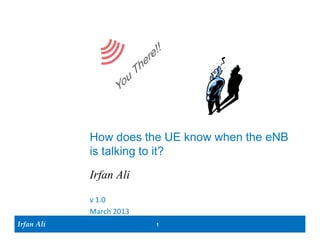
How does the ue know when an eNB is talking to it
- 1. How does the UE know when an eNB is talking to it? Irfan Ali v 1.0 March 2013 Irfan Ali 1
- 2. How does the UE find out when the eNB is talking to it? • To a first approximation (which is sufficient for these slides), the downlink channel for FDD appears as a sequence of 1 ms subframes, as shown below. The first few (typically 3) symbols are used for control signaling (PDCCH) and the remaining of the 14 symbols is the shared channel (PDSCH) which carries both signaling and data traffic. Frequency PDCCH Physical Downlink Control Channel PHICH Physical Hybrid ARQ Indicator Channel PDSCH Physical Downlink Shared Channel Time • The UE checks the PDCCH for its C-RNTI or P-RNTI (0xFFFE) or SI-RNTI (0xFFFF). The C-RNTI is unique to the UE in a cell. The P-RNTI and SI-RNTI are common to all UEs. Technically speaking, the PDCCH has its 16 bit CRC scrambled by the appropriate RNTI. The check for P-RNTI or SI-RNTI is not done in every PDCCH frame but only on selected, “paging occasion”, sub-frames (once every DRX cycle). • If the UE finds its C-RNTI in the PDCCH channel, then it knows that there is a control plane (RRC) or user-plane (PDCP) message for it in the PDSCH portion (symbols 4-14) of the subframe. The PDCCH also points to which part of the PDSCH subframe contains the message for the UE. • The UE then goes to that part of the PDSCH to find out what the message is. • The MAC header in the PDSCH tells the UE whether it is an RRC message or a Data message. Logical Channel ID 0 CCCH (SRB0) Logical Channel ID 1, 2 DCCH (SRB1 and SRB2) RNTI Radio Network Temporary Identity C-RNTI Cell RNTI Logical Channel ID 3-10 DTCH P-RNTI Paging RNTI SI-RNTI System Information RNTI Irfan Ali Irfan Ali 2 2
- 3. How does the UE find out what RRC message is being sent to it in DL direction? • If Logical Channel ID == 0 (SRB0): The “Message Type” field in the RRC message tells the UE what the message is: DL-CCCH-MessageType ::= CHOICE { rrcConnectionReestablishment rrcConnectionReestablishmentReject rrcConnectionReject rrcConnectionSetup } • If Logical Channel ID == 1:2 (SRB1 and SRB2): The “Message Type” field in the RRC message tells the UE what the message is: DL-DCCH-MessageType ::= CHOICE { csfbParametersResponseCDMA2000 dlInformationTransfer handoverFromEUTRAPreparationRequest mobilityFromEUTRACommand rrcConnectionReconfiguration rrcConnectionRelease securityModeCommand ueCapabilityEnquiry counterCheck ueInformationRequest-r9 spare6 NULL, spare5 NULL, spare4 NULL, spare3 NULL, spare2 NULL, spare1 NULL } • If Logical Channel ID == 3:10 (DRBs): The message is a data traffic channel (user plane message) belonging to a particular Data Radio Bearer. It is a PDCP message and the PDCP headers apply. Irfan Ali Irfan Ali 3 3
- 4. But,.. What about the DL MAC messages, how does the UE figure out where these are in the DL channel? (1of2) • Good question, the previous slides are based on the fact that the UE has been provided C-RNTI, i.e has gone past the random access procedure. • There are two messages that the UE receives in the DL direction during the random access procedure: Random Access Response message, and Contention Resolution Identity message. • The PDCCH that points to Random Access Response message has its 16 bit CRC scrambled by the RA- RNTI ( which is the subframe in which the UE had transmitted its random access preamble. • The PDCCH that points to Contention Resolution Identity message has its 16 bit CRC scrambled by the Temporary C-RNTI (the Temporary C-RNTI is provided by the eNB to the UE within the contents of the Random Access Response message) • But, but… how does the UE figure out other MAC control messages from the eNB? • These are the MAC control messages in the downlink direction (ignore multicast related MAC messages): DRX Command MAC Control Element Timing Advance Command MAC Control Element Activation/Deactivation MAC Control Element RA-RNTI Random Access RNTI C-RNTI Cell RNTI Irfan Ali Irfan Ali 4 4
- 5. But... What about the DL MAC messages, how does the UE figure out where these are in the DL channel? (2of2) • The MAC control messages are identified by the Logical Channel ID (LCID) in the MAC header which is sent in the PDSCH resource blocks. (Remember, the UE is pointed to the PDSCH resource blocks by the RNTI in the PDCCH channel). • The LCID mapping to the different MAC control messages is given below: LCID Value (5 Corresponding Channel/MAC Control bits, 0-31) Message 0 Common Control Channel (SRB0) 1-2 Dedicated Control Channel (SRB1 and SRB2) 3-10 Traffic Channels (DRB0-DRB8) 11 - 26 Reserved 27 Activation/Deactivation 28 UE Contention Resolution Identity 29 Timing Advance Command 30 DRX Command 31 Padding • There can be multiple MAC messages (MAC Service Data Units SDU or control element) in one PDSCH allocation. These together are called a MAC Packet Data Unit (PDU). Each MAC SDU or Control Message has a MAC subheader associated with it. Example shown below: MAC Control MAC Control MAC Padding LCID 1 LCID 2 LCID 3 LCID 4 LCID 5 MAC SDU 2 Element 1 Element 2 SDU 1 (opt) MAC Header MAC Payload MAC PDU Irfan Ali Irfan Ali 5 5
- 6. In Summation…. UE Reads the PDCCH Channel P-RNTI SI-RNTI RNTI? RA-RNTI Temporary C-RNTI Random Access Contention Response C-RNTI Resolution Identity Paging Common Control Channel, or Dedicated Control Channel, SIB Information Message or Dedicated Traffic Channel UE Reads the LCID in MAC header of PDSCH MAC Control Elements RRC Channels 27 0 Activation/Deactivation Common Control Channel (SRB0) 28 UE Contention Resolution Identity 1 Dedicated Control Channel (SRB1) 29 LCID? Timing Advance Command 30 2 Dedicated Control Channel (SRB2) DRX Command 3-10 31 Data Radio Bearers Padding DRB0 – DRB7 Irfan Ali Irfan Ali 6 6